Collectin-11 Is an Important Modulator of Retinal Pigment Epithelial Cell Phagocytosis and Cytokine Production
- PMID: 28772263
- PMCID: PMC6738776
- DOI: 10.1159/000478042
Collectin-11 Is an Important Modulator of Retinal Pigment Epithelial Cell Phagocytosis and Cytokine Production
Abstract
In this paper, we report previously unknown roles for collectin-11 (CL-11, a soluble C-type lectin) in modulating the retinal pigment epithelial (RPE) cell functions of phagocytosis and cytokine production. We found that CL-11 and its carbohydrate ligand are expressed in both the murine and human neural retina; these resemble each other in terms of RPE and photoreceptor cells. Functional analysis of murine RPE cells showed that CL-11 facilitates the opsonophagocytosis of photoreceptor outer segments and apoptotic cells, and also upregulates IL-10 production. Mechanistic analysis revealed that calreticulin on the RPE cells is required for CL-11-mediated opsonophagocytosis whereas signal-regulatory protein α and mannosyl residues on the cells are involved in the CL-11-mediated upregulation of IL-10 production. This study is the first to demonstrate the role of CL-11 and the molecular mechanisms involved in modulating RPE cell phagocytosis and cytokine production. It provides a new insight into retinal health and disease and has implications for other phagocytic cells.
Keywords: CL-K1; Collectin 11; Cytokine production; Opsonophagocytosis; Retinal pigment epithelial cells.
© 2017 S. Karger AG, Basel.
Figures

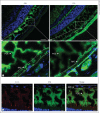
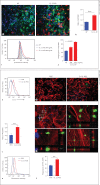
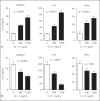
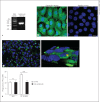
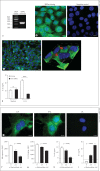

Similar articles
-
Soluble Collectin 11 (CL-11) Acts as an Immunosuppressive Molecule Potentially Used by Stem Cell-Derived Retinal Epithelial Cells to Modulate T Cell Response.Cells. 2023 Jul 7;12(13):1805. doi: 10.3390/cells12131805. Cells. 2023. PMID: 37443840 Free PMC article.
-
Lyar Is a New Ligand for Retinal Pigment Epithelial Phagocytosis.J Cell Biochem. 2015 Oct;116(10):2177-87. doi: 10.1002/jcb.25089. J Cell Biochem. 2015. PMID: 25735755 Free PMC article.
-
CaV1.3 L-type channels, maxiK Ca(2+)-dependent K(+) channels and bestrophin-1 regulate rhythmic photoreceptor outer segment phagocytosis by retinal pigment epithelial cells.Cell Signal. 2014 May;26(5):968-78. doi: 10.1016/j.cellsig.2013.12.021. Epub 2014 Jan 7. Cell Signal. 2014. PMID: 24407175
-
Collectins and collectin receptors in innate immunity.APMIS Suppl. 2000;100:1-59. APMIS Suppl. 2000. PMID: 11021254 Review.
-
Clearance phagocytosis by the retinal pigment epithelial during photoreceptor outer segment renewal: Molecular mechanisms and relation to retinal inflammation.Immunol Rev. 2023 Oct;319(1):81-99. doi: 10.1111/imr.13264. Epub 2023 Aug 9. Immunol Rev. 2023. PMID: 37555340 Free PMC article. Review.
Cited by
-
Development of a Quantitative Assay for the Characterization of Human Collectin-11 (CL-11, CL-K1).Front Immunol. 2018 Sep 28;9:2238. doi: 10.3389/fimmu.2018.02238. eCollection 2018. Front Immunol. 2018. PMID: 30323815 Free PMC article.
-
Methyltransferase-like (METTL)14-mediated N6-methyladenosine modification modulates retinal pigment epithelial (RPE) activity by regulating the methylation of microtubule-associated protein (MAP)2.Bioengineered. 2022 Mar;13(3):4773-4785. doi: 10.1080/21655979.2022.2032968. Bioengineered. 2022. PMID: 35139773 Free PMC article.
-
Role of collectin-11 in innate defence against uropathogenic Escherichia coli infection.Innate Immun. 2021 Jan;27(1):50-60. doi: 10.1177/1753425920974766. Epub 2020 Nov 26. Innate Immun. 2021. PMID: 33241978 Free PMC article.
-
Roles of MASP-1 and MASP-3 in the development of retinal degeneration in a murine model of dry age-related macular degeneration.Front Immunol. 2025 Mar 28;16:1566018. doi: 10.3389/fimmu.2025.1566018. eCollection 2025. Front Immunol. 2025. PMID: 40226626 Free PMC article.
-
A Plausible Role for Collectins in Skin Immune Homeostasis.Front Immunol. 2021 Mar 15;12:594858. doi: 10.3389/fimmu.2021.594858. eCollection 2021. Front Immunol. 2021. PMID: 33790889 Free PMC article. Review.
References
-
- Strauss O. The retinal pigment epithelium in visual function. Physiol Rev. 2005;85:845–881. - PubMed
-
- Keshi H, Sakamoto T, Kawai T, Ohtani K, Katoh T, Jang SJ, Motomura W, Yoshizaki T, Fukuda M, Koyama S, Fukuzawa J, Fukuoh A, Yoshida I, Suzuki Y, Wakamiya N. Identification and characterization of a novel human collectin CL-K1. Microbiol Immunol. 2006;50:1001–1013. - PubMed
-
- Ohtani K, Suzuki Y, Eda S, Kawai T, Kase T, Yamazaki H, Shimada T, Keshi H, Sakai Y, Fukuoh A, Sakamoto T, Wakamiya N. Molecular cloning of a novel human collectin from liver (CL-L1) J Biol Chem. 1999;274:13681–13689. - PubMed
MeSH terms
Substances
Grants and funding
LinkOut - more resources
Full Text Sources
Other Literature Sources
Molecular Biology Databases
Research Materials
Miscellaneous

